

30 Examples: How to Conclude a Presentation (Effective Closing Techniques)
By Status.net Editorial Team on March 4, 2024 — 9 minutes to read
Ending a presentation on a high note is a skill that can set you apart from the rest. It’s the final chance to leave an impact on your audience, ensuring they walk away with the key messages embedded in their minds. This moment is about driving your points home and making sure they resonate. Crafting a memorable closing isn’t just about summarizing key points, though that’s part of it, but also about providing value that sticks with your listeners long after they’ve left the room.
Crafting Your Core Message
To leave a lasting impression, your presentation’s conclusion should clearly reflect your core message. This is your chance to reinforce the takeaways and leave the audience thinking about your presentation long after it ends.
Identifying Key Points
Start by recognizing what you want your audience to remember. Think about the main ideas that shaped your talk. Make a list like this:
- The problem your presentation addresses.
- The evidence that supports your argument.
- The solution you propose or the action you want the audience to take.
These key points become the pillars of your core message.
Contextualizing the Presentation
Provide context by briefly relating back to the content of the whole presentation. For example:
- Reference a statistic you shared in the opening, and how it ties into the conclusion.
- Mention a case study that underlines the importance of your message.
Connecting these elements gives your message cohesion and makes your conclusion resonate with the framework of your presentation.
30 Example Phrases: How to Conclude a Presentation
- 1. “In summary, let’s revisit the key takeaways from today’s presentation.”
- 2. “Thank you for your attention. Let’s move forward together.”
- 3. “That brings us to the end. I’m open to any questions you may have.”
- 4. “I’ll leave you with this final thought to ponder as we conclude.”
- 5. “Let’s recap the main points before we wrap up.”
- 6. “I appreciate your engagement. Now, let’s turn these ideas into action.”
- 7. “We’ve covered a lot today. To conclude, remember these crucial points.”
- 8. “As we reach the end, I’d like to emphasize our call to action.”
- 9. “Before we close, let’s quickly review what we’ve learned.”
- 10. “Thank you for joining me on this journey. I look forward to our next steps.”
- 11. “In closing, I’d like to thank everyone for their participation.”
- 12. “Let’s conclude with a reminder of the impact we can make together.”
- 13. “To wrap up our session, here’s a brief summary of our discussion.”
- 14. “I’m grateful for the opportunity to present to you. Any final thoughts?”
- 15. “And that’s a wrap. I welcome any final questions or comments.”
- 16. “As we conclude, let’s remember the objectives we’ve set today.”
- 17. “Thank you for your time. Let’s apply these insights to achieve success.”
- 18. “In conclusion, your feedback is valuable, and I’m here to listen.”
- 19. “Before we part, let’s take a moment to reflect on our key messages.”
- 20. “I’ll end with an invitation for all of us to take the next step.”
- 21. “As we close, let’s commit to the goals we’ve outlined today.”
- 22. “Thank you for your attention. Let’s keep the conversation going.”
- 23. “In conclusion, let’s make a difference, starting now.”
- 24. “I’ll leave you with these final words to consider as we end our time together.”
- 25. “Before we conclude, remember that change starts with our actions today.”
- 26. “Thank you for the lively discussion. Let’s continue to build on these ideas.”
- 27. “As we wrap up, I encourage you to reach out with any further questions.”
- 28. “In closing, I’d like to express my gratitude for your valuable input.”
- 29. “Let’s conclude on a high note and take these learnings forward.”
- 30. “Thank you for your time today. Let’s end with a commitment to progress.”
Summarizing the Main Points
When you reach the end of your presentation, summarizing the main points helps your audience retain the important information you’ve shared. Crafting a memorable summary enables your listeners to walk away with a clear understanding of your message.
Effective Methods of Summarization
To effectively summarize your presentation, you need to distill complex information into concise, digestible pieces. Start by revisiting the overarching theme of your talk and then narrow down to the core messages. Use plain language and imagery to make the enduring ideas stick. Here are some examples of how to do this:
- Use analogies that relate to common experiences to recap complex concepts.
- Incorporate visuals or gestures that reinforce your main arguments.
The Rule of Three
The Rule of Three is a classic writing and communication principle. It means presenting ideas in a trio, which is a pattern that’s easy for people to understand and remember. For instance, you might say, “Our plan will save time, cut costs, and improve quality.” This structure has a pleasing rhythm and makes the content more memorable. Some examples include:
- “This software is fast, user-friendly, and secure.”
- Pointing out a product’s “durability, affordability, and eco-friendliness.”
Reiterating the Main Points
Finally, you want to circle back to the key takeaways of your presentation. Rephrase your main points without introducing new information. This reinforcement supports your audience’s memory and understanding of the material. You might summarize key takeaways like this:
- Mention the problem you addressed, the solution you propose, and the benefits of this solution.
- Highlighting the outcomes of adopting your strategy: higher efficiency, greater satisfaction, and increased revenue.
Creating a Strong Conclusion
The final moments of your presentation are your chance to leave your audience with a powerful lasting impression. A strong conclusion is more than just summarizing—it’s your opportunity to invoke thought, inspire action, and make your message memorable.
Incorporating a Call to Action
A call to action is your parting request to your audience. You want to inspire them to take a specific action or think differently as a result of what they’ve heard. To do this effectively:
- Be clear about what you’re asking.
- Explain why their action is needed.
- Make it as simple as possible for them to take the next steps.
Example Phrases:
- “Start making a difference today by…”
- “Join us in this effort by…”
- “Take the leap and commit to…”
Leaving a Lasting Impression
End your presentation with something memorable. This can be a powerful quote, an inspirational statement, or a compelling story that underscores your main points. The goal here is to resonate with your audience on an emotional level so that your message sticks with them long after they leave.
- “In the words of [Influential Person], ‘…'”
- “Imagine a world where…”
- “This is more than just [Topic]; it’s about…”
Enhancing Audience Engagement
To hold your audience’s attention and ensure they leave with a lasting impression of your presentation, fostering interaction is key.
Q&A Sessions
It’s important to integrate a Q&A session because it allows for direct communication between you and your audience. This interactive segment helps clarify any uncertainties and encourages active participation. Plan for this by designating a time slot towards the end of your presentation and invite questions that promote discussion.
- “I’d love to hear your thoughts; what questions do you have?”
- “Let’s dive into any questions you might have. Who would like to start?”
- “Feel free to ask any questions, whether they’re clarifications or deeper inquiries about the topic.”
Encouraging Audience Participation
Getting your audience involved can transform a good presentation into a great one. Use open-ended questions that provoke thought and allow audience members to reflect on how your content relates to them. Additionally, inviting volunteers to participate in a demonstration or share their experiences keeps everyone engaged and adds a personal touch to your talk.
- “Could someone give me an example of how you’ve encountered this in your work?”
- “I’d appreciate a volunteer to help demonstrate this concept. Who’s interested?”
- “How do you see this information impacting your daily tasks? Let’s discuss!”
Delivering a Persuasive Ending
At the end of your presentation, you have the power to leave a lasting impact on your audience. A persuasive ending can drive home your key message and encourage action.
Sales and Persuasion Tactics
When you’re concluding a presentation with the goal of selling a product or idea, employ carefully chosen sales and persuasion tactics. One method is to summarize the key benefits of your offering, reminding your audience why it’s important to act. For example, if you’ve just presented a new software tool, recap how it will save time and increase productivity. Another tactic is the ‘call to action’, which should be clear and direct, such as “Start your free trial today to experience the benefits first-hand!” Furthermore, using a touch of urgency, like “Offer expires soon!”, can nudge your audience to act promptly.
Final Impressions and Professionalism
Your closing statement is a chance to solidify your professional image and leave a positive impression. It’s important to display confidence and poise. Consider thanking your audience for their time and offering to answer any questions. Make sure to end on a high note by summarizing your message in a concise and memorable way. If your topic was on renewable energy, you might conclude by saying, “Let’s take a leap towards a greener future by adopting these solutions today.” This reinforces your main points and encourages your listeners to think or act differently when they leave.
Frequently Asked Questions
What are some creative strategies for ending a presentation memorably.
To end your presentation in a memorable way, consider incorporating a call to action that engages your audience to take the next step. Another strategy is to finish with a thought-provoking question or a surprising fact that resonates with your listeners.
Can you suggest some powerful quotes suitable for concluding a presentation?
Yes, using a quote can be very effective. For example, Maya Angelou’s “People will forget what you said, people will forget what you did, but people will never forget how you made them feel,” can reinforce the emotional impact of your presentation.
What is an effective way to write a conclusion that summarizes a presentation?
An effective conclusion should recap the main points succinctly, highlighting what you want your audience to remember. A good way to conclude is by restating your thesis and then briefly summarizing the supporting points you made.
As a student, how can I leave a strong impression with my presentation’s closing remarks?
To leave a strong impression, consider sharing a personal anecdote related to your topic that demonstrates passion and conviction. This helps humanize your content and makes the message more relatable to your audience.
How can I appropriately thank my audience at the close of my presentation?
A simple and sincere expression of gratitude is always appropriate. You might say, “Thank you for your attention and engagement today,” to convey appreciation while also acknowledging their participation.
What are some examples of a compelling closing sentence in a presentation?
A compelling closing sentence could be something like, “Together, let’s take the leap towards a greener future,” if you’re presenting on sustainability. This sentence is impactful, calls for united action, and leaves your audience with a clear message.
- 30 Examples of Teamwork Self Evaluation Comments
- Effective Nonverbal Communication in the Workplace (Examples)
- 30 Examples of Follow-Up Email Subject Lines
- 5 Effective Examples: How to Write a Two-Week Notice
- 2 Examples of an Effective and Warm Letter of Welcome
- 8 Examples of Effective Interview Confirmation Emails
- Student Login:

How to Close Your Presentation in English Powerfully [+ FREE Presentation Checklist]
May 9, 2018 | Business Professional English , Free Resource , Public Speaking & Presentations

This lesson has been updated from its original posting in 2016.
You’re giving your presentation in English. You have just two minutes left. And it’s time for the conclusion …
Did you know most people only remember the first and last things you tell them? It’s true.
If you are giving a presentation in English, then you definitely want people to remember what you say at the end. And this means your closing must be powerful!
You’ve worked hard on your presentation. You searched for information online. You couldn’t sleep at night. You felt nervous about making mistakes. You spent hours preparing. You reviewed the grammar and vocabulary. You worried about someone asking a question. You practiced and practiced and practiced.
And now it’s the last two minutes. This is the last opportunity for your audience to hear your key points. It is the last chance you have to help your audience remember your comments.
A closing in a presentation should be short and clear. It should summarize your key points. And, most importantly, it should be powerful.
In today’s lesson, you’re going to learn about 3 ways to make your closing more powerful. Plus you’ll learn useful key expressions you can use in your presentation.
3 steps to a powerful closing in your presentation.
Lesson by Annemarie
3 Strategies to Close Your Presentation Powerfully
Use these 3 strategies in your conclusion to:
- recapture your audience’s attention
- get your audience to focus and remember your key points
- help your audience connect with you and your topic
- end your presentation powerfully
One: Include a Call to Action (CTA)
Is there something you want your audience to do or think after your presentation. Do you want them to take action? Tell your audience exactly what you want them to do with a Call to Action.
Here’s my example:
“ After you finish today’s lesson, please take 2 minutes to leave a comment about your experience with presentations. You can share your thoughts or ask questions in the comments section at the bottom of this lesson – it’s the perfect place to join a discussion on this topic.”
A couple useful expressions to help you introduce your CTA is:
- To close, I’d like to ask you to do this one thing…
- And finally, before you leave the conference today, please take two minutes to…
Two: End with a Powerful/Inspirational Quote
Is there one thing you really want your audience to remember? Or is there a specific feeling you want your audience to have after your presentation?
Using a powerful quote can help you do that. You could introduce a great quote or interesting statistic with:
- I’d like to finish with this powerful/interesting/wonderful/inspiring/ quote from …
- And finally, let’s finish up today’s discussion with this surprising/useful/shocking/hopeful statistic …
Here are some example quotes that might help people be prepared to take action or to think differently. But remember! Always match the quote or statistic to your topic:
“In the end, we will remember not the words of our enemies, but the silence of our friends.” – Martin Luther King, Jr. “Sometimes we stare so long at a door that is closing that we see too late the one that is open.” – Alexander Graham Bell
Three: Add a Surprising Fact or Statistic
Is there something you’d love for your audience to think about after your presentation? Is there a statistic or fact that will help someone remember your key points?
A surprising fact can also help re-engage your audience, it will snap their attention back to you.
For example:
Did you know that the human brain’s capacity is limitless – that’s great new right? BUT … did you also know that a person is likely to remember only 25% of a presentation after 24 hours?
Uh oh. That is why it’s SO important to have a powerful ending! Remember: the key is to find a statistic or fact that connects directly to your topic.
Useful Language to Close Your Presentation
Summarize Your Key Points & Close Your Presentation
- That brings us to the end of the presentation. I’d like to summarize by saying …
- That concludes my presentation. However, I’d like to quickly summarize the main points or takeaways.
- And on that final note, that concludes my presentation.
- To quickly recap, I’d like you to remember these key points …
- To summarize …
- In conclusion …
- I’d like to bring this presentation to a close with …
- I’d like to close this talk with …
- So, this concludes the focus of discussion today. To end, I’d like to highlight …
- This concludes [name/title of the section] so let’s move on to the final comments.
Thank Your Audience
- I sincerely appreciate your attention today/this evening/this morning.
- And that brings us to the end. I’d like to thank you for your time and attention today.
- Thank you so much for your interest and attention.
- At this time, I’d like to have my colleague speak so I’ll finish up by saying thank you for your attention.
- I can see that our time is just about up so to finish I’d like to say thank you.
- I sincerely appreciate that I’ve had this opportunity to present to you.
- If there is one thing I would like you to remember from today’s presentation it’s …
Take Questions
- If anyone has any questions, I’d be happy to open up the discussion.
- If anyone has any questions, please feel free to ask now and I’ll do my best to answer.
- Would anyone like to ask any questions?
- I would now be interested to hear from you with your thoughts or questions.
- Now let’s move on to some Q&A. (Q&A = Questions and Answers)
Provide Next Steps or Contact Information
- If you would like more information, here is a list of useful resources/websites.
- If anyone who like more information or has questions, please feel free to contact me at: [include contact info]
- Here is a list for further reading on this topic. (Include the list of books or websites.)
Get the complete Presentations in English Series:
Part 1: How to Prepare for Your Presentation in English
Part 2: How to Start with a Great Introduction in Your Presentation
Part 3: How to Organize Your Presentation in English
Part 4: How to End Your Presentation Powerfully
After you’ve watched the video and reviewed the lesson, I’d love to hear from you!
Tell me about the best presentation you ever heard. Who gave the presentation? And why do you remember it? Share what you remember in the comments section below.
And for the bonus question!! Have you given a presentation in English? What tips or advice would you like to share with others? You can add your advice in the comments section.
Thank you so much for joining me!
~ Annemarie
Get the Confidence to Say What You Want in English
Follow my 3-step solution to speak English with clarity, fluency, and freedom so you can say what you want with confidence.
You'll also get my Confident English lessons delivered by email every Wednesday and occasional information about available courses. You can unsubscribe any time.
More Like This

#328: Be More Expressive in English Conversations | Reaction Words & Interjections
Learn 37 essential English reaction words and sounds to express yourself naturally. Perfect for sounding more authentic in English conversations.
![presentation closing lines #327: How to Respond to Thank You in English [FREE Guide]](https://www.speakconfidentenglish.com/wp-content/uploads/2024/12/Respond-to-Thank-You-400x250.webp)
#327: How to Respond to Thank You in English [FREE Guide]
Discover exactly when and how to use expressions like “no worries,” “my pleasure,” and more to sound natural and build better professional relationships in English-speaking workplaces.

#326: English Conversations on Health & Wellness | Advanced Vocabulary
Master advanced English vocabulary for health and wellness conversations! Perfect for enhancing your fluency on modern health topics. This comprehensive guide covers essential terminology in four cutting-edge areas: complementary and alternative medicine, mental health, health technology, and aging & diet.

#325: Prepositions of Time | At, On, In, Before, By, Until, Since, For, Ahead Of
With no simple rules, prepositions are often tricky, especially when they don’t translate directly from your native language. In today’s lesson, we’ll explore these essential time prepositions in themes to help you use them accurately.

#324: Talk about Health | Describe Common Aches and Pains in English
Learn natural English expressions to describe aches and pains in English! Perfect for explaining symptoms to doctors, discussing health with colleagues, or sharing experiences with friends.

#323: Should vs. Be Supposed To vs. Have To vs. Must | Talking about Obligation
Is there a difference between should vs. be supposed to vs. have to vs. must when talking about obligation in English? Yes! The differences are subtle but important.
© Copyright 2014-2024 Speak Confident English | Privacy Policy | Terms & Disclaimer | Online Class Policies
I’m glad to hear it was helpful!
This was very helpful
Thanks, Ma’am/Sir. This helped me a lot…
Same here ma’am
This is so helpful. Thank you so much
This helped a lot. Thank you so much <3
I accidentally found your page while working on my English video presentation. It’s really helpful. Thanks soooo much 🙂
I’m very glad to know it was helpful!
Hi! I found your page very insightful. Thank you very much!
I’m glad to hear it!
great video series. thank you so much. you mentioned that you had a downloadable checklist in the final video. where could I find this thanks?
Hi Ellie, I’m glad the series was helpful.
When you visit the lesson, there should be an image that pops up with an opportunity to get the download. If you don’t see it, please let me know so I can fix it.
Helped a lot! Thank you very much <33
thank you so much
I love your method
Hello, I have a 5 minute oral presentation of a fictional book, w/the main focus on the leadership traits of the characters. I enjoyed the book, and suspect others might, so to that end, is it OK to NOT share the ending? Thank you
Thanks for your help 🙂
Great website. I found a typo in on the presentation closings page “Useful Langauge to Close Your Presentation”.
Good eyes! Thanks so much for the note. We’ve fixed the typo.
Dear Annemarie, thank you so much for sharing.
Dear Annemarie, thank you so much for sharing. I learned so much from your 4 videos and I will work on improving my presentation skills. Love your spirit of excellence. For me as a presenter, its important i am passionate about the topic i share and audience will be able to apply some of the learnings in their life. Thank you Annemarie. I love your voice too. Stay blessed.
I watch continuously watched ur 4 videos and U r a great teacher.Thanks for making such purposeful videos.
I am so happy , I have more form you thank you very much
You are absolutely wonderful and your website is extremely useful and also quit impressive i habe my english A-levels in December i copied this text i sinisterly appreciate that i have had this opportunity to present to you and i also add something * it was a honor for me so thank you ☺️
Thanks, Jasmin! I’m so glad to know my lessons are helpful to you.
hey Annemarie could you help me in ending my presentation on mental health. it is a school presentation for MUN
If you’d like editing help, please see our options for 1:1 classes .
You are my favorite speaker. ☺
Hi Anna, that’s so kind of you. Thank you. 🙂
It’s so useful to us…… I’m so happy by this
I’m glad it was helpful to you, Kalpana.
I was holistically stuck about how to give my first ever presentation, but this gave me an impetus and confidence. Thanks a lot for this exquisite info
Awesome. I’m glad this helped you to move forward.
Thank YOU for tour tips. They are really inspiring. I Will try to put them into practise.
Hi Nancy, Wonderful! I’m glad they’re helpful to you!
It’s so useful to us…… I’m so happy by this
do you have Presentation course
Hi Hammad, I don’t at this time but it’s definitely something I’m thinking about.
Pin It on Pinterest
10 Powerful Examples of How to End a Presentation
- By Illiya Vjestica
- - January 23, 2023
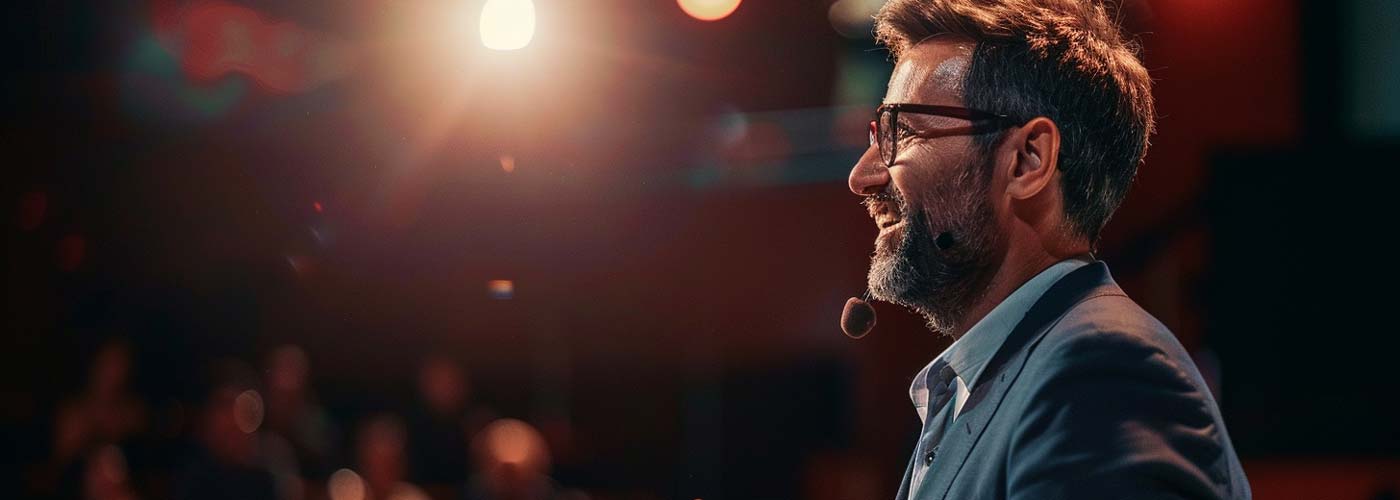
Here are 10 powerful examples of how to end a presentation that does not end with a thank you slide.
How many presentations have you seen that end with “Thank you for listening” or “Any questions?” I bet it’s a lot…
“Thank you for listening.” is the most common example. Unfortunately, when it comes to closing out your slides ending with “thank you” is the norm. We can create a better presentation ending by following these simple examples.
The two most essential slides of your deck are the ending and intro. An excellent presentation ending is critical to helping the audience to the next step or following a specific call to action.
There are many ways you can increase your presentation retention rate . The most critical steps are having a solid call to action at the end of your presentation and a powerful hook that draws your audience in.
What Action do You Want Your Audience to Take?
Before designing your presentation, start with this question – what message or action will you leave your audience with?
Are you looking to persuade, inspire, entertain or inform your audience? You can choose one or multiple words to describe the intent of your presentation.
Think about the action words that best describe your presentation ending – what do you want them to do? Inspire, book, learn, understand, engage, donate, buy, book or schedule. These are a few examples.
If the goal of your presentation is to inspire, why not end with a powerful and inspiring quote ? Let words of wisdom be the spark that ignites an action within your audience.
Here are three ways to end your presentation:
- Call to Action – getting the audience to take a specific action or next step, for example, booking a call, signing up for an event or donating to your cause.
- Persuade – persuading your audience to think differently, try something new, undertake a challenge or join your movement or community.
- Summarise – A summary of the key points and information you want the audience to remember. If you decide to summarise your talk at the end, keep it to no more than three main points.
10 Examples of How to End a Presentation
1. Asking your audience to take action or make a pledge.
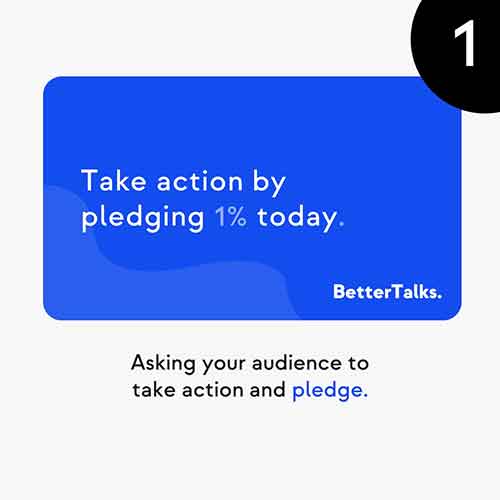
Here were asking the audience to take action by using the wording “take action” in our copy. This call to action is a pledge to donate. A clear message like this can be helpful for charities and non-profits looking to raise funding for their campaign or cause.
2. Encourage your audience to take a specific action, e.g. joining your cause or community
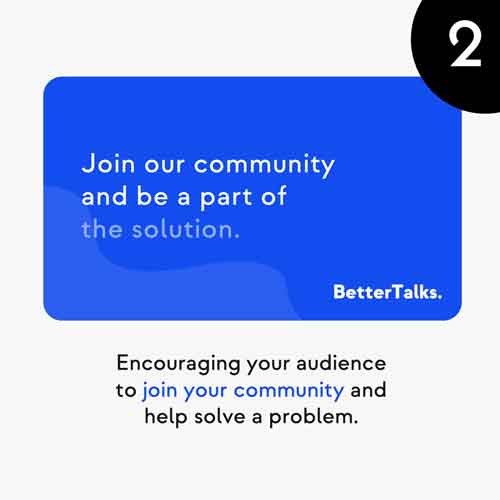
Here was are asking the audience to join our community and help solve a problem by becoming part of the solution. It’s a simple call to action. You can pass the touch to your audience and ask them to take the next lead.
3. Highlight the critical points for your audience to remember.
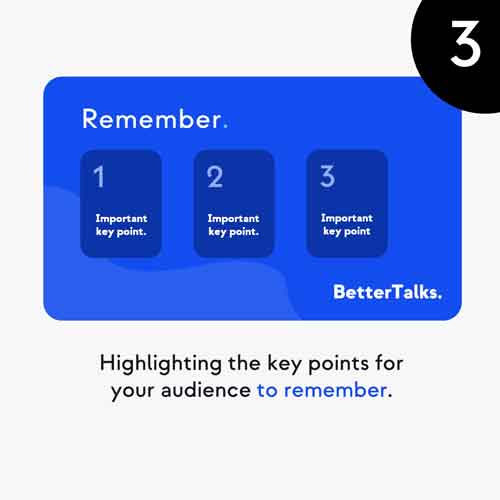
Rember, to summarise your presentation into no more than three key points. This is important because the human brain struggles to remember more than three pieces of information simultaneously. We call this the “Rule of Three”.
4. If you are trying to get more leads or sales end with a call to action to book a demo or schedule a call.
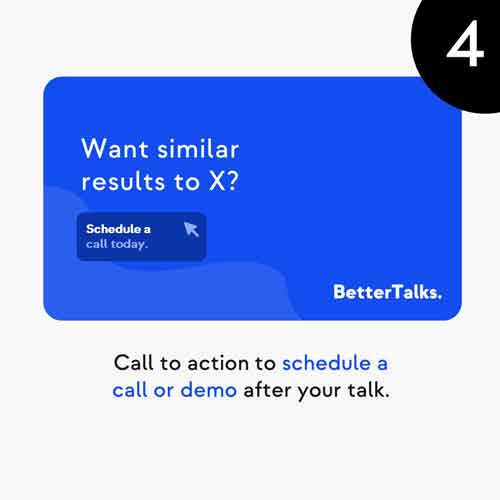
Can you inspire your audience to sign up for a demo or trial of your product? Structure your talk to lead your prospect through a journey of the results you generate for other clients. At the end of your deck, finish with a specific call to action, such as “Want similar results to X?”
Make sure you design a button, or graphic your prospect can click on when you send them the PDF version of the slides.
5. Challenge your audience to think differently or take action, e.g. what impact could they make?
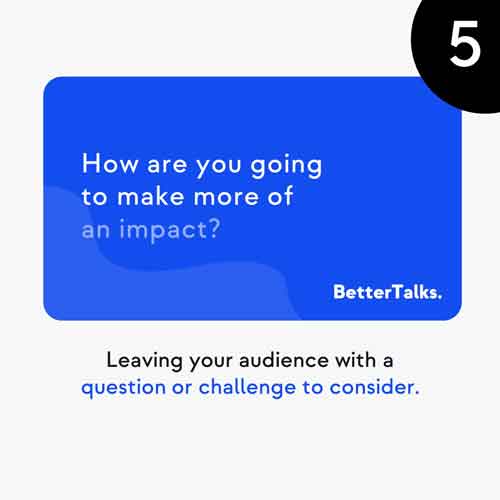
6. Give your audience actions to help share your message.
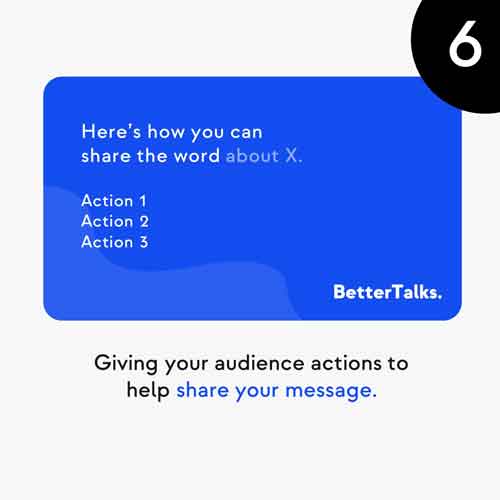
7. Promote your upcoming events or workshops
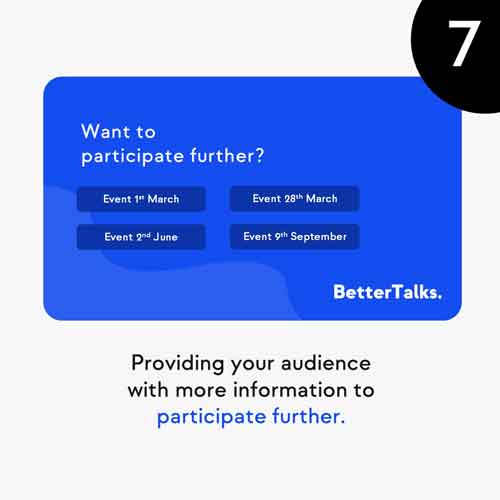
8. Asking your audience to become a volunteer.
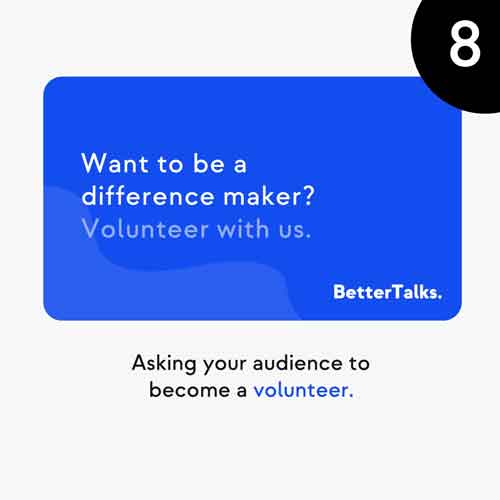
9. Direct your audience to learn more about your website.
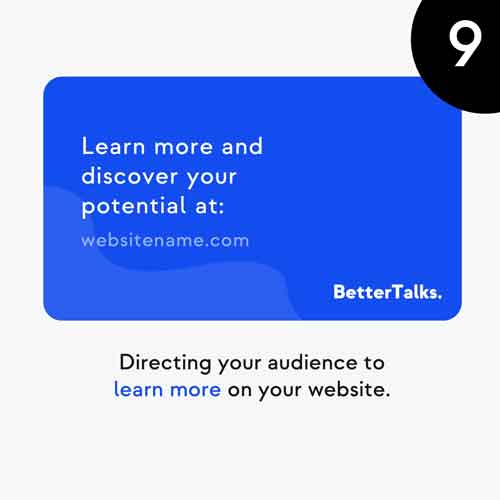
10. If you are a book author, encourage your audience to engage with your book.
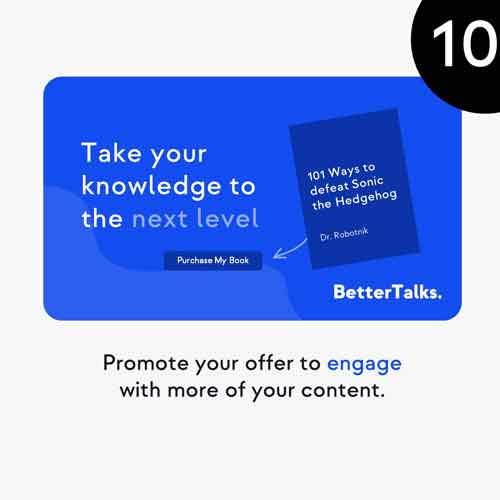
6 Questions to Generate an Ending for Your Presentation
You’ve told an engaging story, but why end your presentation without leaving your audience a clear message or call to action?
Here are six great questions you can ask yourself to generate an ending for your presentation or keynote talk.
- What impression would you want to leave your audience with?
- What is the big idea you want to leave them with?
- What action should they take next?
- What key point should you remember 72 hours after your presentation?
- What do you want them to feel?
- What is the key takeaway for them to understand?
What to Say After Ending a Presentation?
When you get to the end of a book, you don’t see the author say, “thank you for reading my last chapter.” Of course, there is no harm in thanking the audience after your presentation ends, but don’t make that the last words you speak.
Think of the ending of the presentation as the final chapter of an epic novel. It’s your chance to leave a lasting impression on the audience. Close with an impactful ending and leave them feeling empowered, invigorated and engaged.
- Leave a lasting impression.
- Think of it as the last chapter of a book.
- Conclude with a thought or question.
- Leave the audience with a specific action or next step.
How to End a Presentation with Style?
There are many great ways you can end your presentation with style. Are you ready to drop the mic?
Ensure your closing slide is punchy, has a clear headline, or uses a thought-provoking image.
You want to capture the audience’s attention before closing the presentation. Make sure the fonts you choose and are clear and easy to read. And What are the Best Colours for Your PowerPoint presentation? Use them wisely.
Do you need to consider adding a link? If you add links to your social media accounts, use icons and buttons to make them easy to see. Add a link to each button or icon. By doing this, if you send the PDF slides to people, they can follow the links to your various accounts.
What Should you Remember?
💡 If you take one thing away from this post, it’s to lose the traditional ending slides. Let’s move on from the “Thank you for your attention.” or “Any questions.” slides.
These don’t help you or the audience. Respect them and think about what they should do next. You may be interested to learn 3 Tactics to Free Your Presentation Style to help you connect to your audience.
Create stunning presentations with our templates, toolkits and guides.
Illiya Vjestica
Share this post:, related posts.
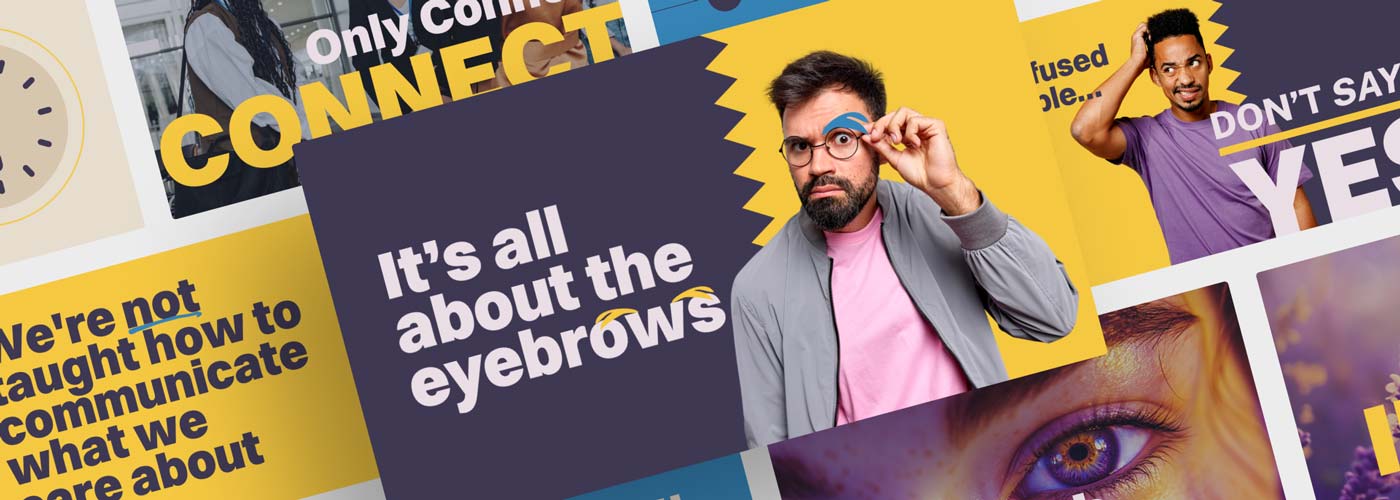
Make Your Slides Intriguing Like Author Sam Horn

7 Surprising Benefits of Using Google Slides
Leave a comment cancel reply.
Your email address will not be published. Required fields are marked *
We use cookies to enhance your experience. By continuing to visit this site, you agree to our use of cookies

25 Ways to End a Speech or Presentation
You have just given a great presentation that had your audience wrapt the entire time, and it is time to bring it to a close. Just as you want to start your presentation strong, you want to finish strong to really bring home your point and leave your audience with a positive lasting impression. Here are 25 effective ways to end a speech or presentation.
1. Plan Your Closing Remarks Word for Word You have to be careful about how you end your speech or presentation, so planning your conclusion word for word is the best way to go. Ask yourself what the purpose of this speech is, and your answer should involve the actions that you want to see be taken by your listeners after you finish speaking. Be clear about the end result you prefer to have, and it will become much easier to create a conclusion that will motivate your listeners to take that action. Sometimes planning your close before the rest of your speech is the best strategy.
2. Quote Depending on what kind of quote you use, it can stay with audience members long after they leave the room. If you are presenting a speech about how to motivate staffs at the workplace, you can share tips and techniques that have worked for you, but a powerful way of getting your message across to the audience is to wrap your message around a simple quote that is relevant to what you discuss.
“Research indicates that workers have three prime needs: Interesting work, recognition for doing a good job, and being let in on things that are going on in the company.” -Zig Ziglar
3. Call to Action The primary purpose of most business presentations is to compel the audience to take action. Use the last few minutes of your presentation to reinforce the call to action you seek. Whatever you say in telling the audience what to do, imagine an exclamation point at the end. Pick up your energy and tempo as you get to your conclusion, speak with authority and emphasis, and drive the final point home. Whether they agree or disagree with your message, you should make it perfectly clear to the audience what you are asking for. Examples of strong calls to action include:
“Finish the Fight” “Start the Adventure” “Improve the Process” “Contribute Today”
4. Summary Speeches have a simple formula. First, you tell people what you are going to tell them. Second, you tell them. Then, you tell them what you have told them. When you reach the end of your speech, say something like “Let me briefly restate my main points”, and you then list your main points one by one. By showing the audience how each point is linked with each other, they will learn to appreciate the structure of your message. Having a summary at the end is effective in getting the audience to understand why all of your points related to each other and mattered.
5. Close With A Story Especially if it is of personal significance to you, or if it illustrates how the presented content affects other people, telling a compelling story to end your presentation is one of the strongest ways to conclude. When approaching the end of your talk, you can say “Let me tell you a story that shows you what I mean” , then you tell the story that has a moral to it. You tell the audience what the moral is, and you don’t leave it to them to figure it out for themselves.
6. Humor Having a sense of humor lightens the mood of any speech, especially if your speech ends with laughs. Telling a joke that circles back into your core subject and repeats the main point you are making with a certain detail that makes the audience laugh will have a lasting impression. While it is not as easy as saying “Two bears walk into a bar”, highlighting a funny part of an otherwise serious story establishes common ground between you and the audience, and it won’t take away from the key points you were making in your speech.
7. Repetitive Close In some cases, repetition can be a negative thing, but when it comes to speeches and presentations it can play a pivotal role in motivating an audience. Find a phrase and structure it in a repetitive format that beats to its own drum, building to a crescendo ending of a motivational speech. As long as your chosen phrase remains consistent to the heart of your message, repeating the phrase brings the message home for your audience.
“Governments cannot legislate it. Judges cannot adjudicate it. Lawyers cannot litigate it. Politicians cannot appropriate it. Only you can orchestrate it.”
8. Be Poetic There are many great poems that contain messages that summarize the main points you want to make. Choose a poem that is moving, dramatic, or emotional, and it doesn’t necessarily have to rhyme. Some of the best poems ever made don’t rigidly rhyme word for word. As someone who writes speeches, this is the chance for you to express yourself in a creative way while you also keep the emphasis on the main points of your message. Delivering a powerful close to a speech sometimes involves having a poetic tone and structure, as long as you stay consistent with the core of your message.
9. A Running Clock PowerPoint has a feature where a timer is often seen in its software. You can use a timer to schedule breaks in between presentations, but you can also implement timers for speeches themselves, putting yourself on the spot as a speaker. In the “Create Your Own Change” talks run by marketing and advertising executive Dietmar Dahmen, a running clock accompanies his last statement. Dahmen normally says “Users rule, so stop waiting and start doing. And you have to do that now because time is running out.”
If you deliver a time-sensitive message and you want to urge your listeners to move quickly, add a background slide with a running timer to put more emphasis on your last statement.
10. Echo Close Focus on a single word in a quotation and continue to emphasize that word to echo your last statement. For example, if you want to wrap your message around the word “understand”, consider using it at least five times at the end of your speech. This will let the audience know that having a great understanding of the topic you are discussing matters.
“Once we understand what is required of us in advertising, we go forward with that knowledge. Successful advertisers understand that powerful messages sell. If you don’t understand how to sell, you can’t advertise. Understand that we are in this together as a team. Before we can grow our business, we must understand the business.”
11. Make It Clear You Have Concluded All too often there is the temptation for you to shuffle papers around, fidget with your clothes or microphone, or move forward, backward or sideways. If you do anything else aside from standing still like a tree, then chances are that you won’t make an impact when ending your speech. When you say your final words, they should be made clear. No ambiguity or confusion should be in the minds of your audience. They should know when it is over. When you finish, discipline yourself to stand perfectly still. Select a friendly face in the audience and look straight at that person.
12. Title Close Your speech should have a provocative title attached to it. Having a title that encapsulates your message memorably will stay in the minds of listeners for some time. Use the title of your speech as your closing words to encourage your audience to think harder about what they have just heard, reinforcing the title of the speech that you referenced earlier. Mentioning the title of your speech at the end allows you to bring everything logically back full circle.
13. Blank the Screen If you are using slides for your presentation, consider blanking the screen towards the end of it. This will change the mood of the audience in the room and it will force them to put their focus back on you as you deliver your last statement. If you know you are working with an audience that loves to see visuals, blanking the screen will send a message of its own to keep things in perspective. Afterward, you can refer back to the visuals you presented and reveal to the audience the main reasons why you presented them.
14. A Visual Image Sometimes you will be speaking to an audience that needs to see an image at the end to remember all the key points of what you said. End your presentation with a riveting visual that connects to your last statement. Leave this slide on when you finish, and give your audience enough time after your presentation to look at this image. Remember that famous saying “A picture is worth a thousand words” , and apply that saying to this close. A lasting image reinforces your message.
15. Bookend Close If you want to give your speech a bookend, then you will have to refer back to your opening anecdote or quote and say something like “Now we have arrived at where we began.” After saying this, reiterate the message that you want your audience to remember. The classic three-part speech outline of “Tell them what you are going to tell them; tell them, then tell them what you just told them” will be completed with closings like this. By coming back full circle to what you said in the beginning, the entirety of your message will be remembered more clearly by the audience.
16. Movie or Book Close Making a reference to a well-known movie or book will allow the audience to view your speech from a different angle. If you want to provide a history lesson to the audience, you can refer back to the 1915 film “The Birth of a Nation” and its last line of “Liberty and Union, one and inseparable, now and forever!” , and use this line to relate to your political message. You can also refer to fictional stories like “The Prince and the Pauper” and how its ending can relate to a message about the economy. “That means that as long as you live, you’ll have money to live on. And if anybody’s unkind or cruel to you, they’ve committed an offense against the Crown.”
17. Thanking People or Companies There are times when it is appropriate for you to thank people publicly for helping you. These times include when you present a research paper and want to thank people involved in the project, presenting data or information obtained from a company or person, or when someone gave you considerable help in building a presentation that was particularly complex to begin with. If you are using PowerPoint to show slides, use its credits feature to spruce up your speech.
18. End with a Statement One mistake you will often make when you are just beginning your journey in public speaking is that you end your speeches by asking the audience a question. Upward inflection is a question, and this means that you are implying to the audience that there is more coming. Saving questions for the end doesn’t work well. Downward inflection is a statement. When you know for certain that you have a strong ending, you automatically speak with authority, which makes it easier to add impact with your voice and emphasize your message.
19. Let Them Applaud When you finish your speech, the audience members will want to give start clapping. What they will need from you will be a clear signal that now is the time to begin applauding. Some people will recognize sooner than others that you have finished. In many cases, when it becomes clear that you have stopped talking, the audience members will be silent. They may not know what to do until someone else does something. Within seconds one will start clapping, then another, and then the entire audience will clap. You look at the first person who starts clapping and say “Thank you”, and let the round of applause come.
20. Cartoon or Animation Sometimes a single visual image that doesn’t change won’t be enough to illustrate your final point to the audience. Depending on what your speech is about, you will find the need to use a relevant cartoon or short animation to convey your message to the masses. For example, if you want to warn people not to fall into any holes that the business world has in store for them, you can play a short clip of a cartoon character walking down a road and then falling into a hole. Have your message relate to becoming more aware of the dangers that can come from unhealthy work environments.
21. Third-Party Close Leverage the use of a quotation in the context of your message. Use the premise of that quotation to frame your closing. This will serve as a launching pad to lift up your message for the audience to better appreciate. Here is how you can conclude a speech on the importance of embracing change:
“Change plays a significant role in life. Recall the insight of President Abraham Lincoln, staring at a Civil War and fighting the near 100-year long tradition of slavery in the United States, Lincoln addressed change by saying:
‘The dogmas of the quiet past are inadequate for the stormy present and future. As our circumstances are new, we must think anew and act anew.’
We need to look at this old issue in a new way, not simply for today but to make our tomorrows more rewarding, more fulfilling, and more compelling because of the change we make today. With your help, we can think anew and act anew on the issue before us today.”
22. Callback Close If you started your speech with a story, but some activity in it wasn’t fully completed, it would be wise to finish your story and close it around your theme. Here is how to call back to your story:
“Remember that paintbrush that toddler held so gently in his hands? Well, now those same gentle hands are poised skillfully for designing graphics. Today he runs a graphic design company.”
23. Sing Song Close Ask the audience to repeat a phrase that you used several times in your speech. If your phrase happens to be “We finish the race together” , you repeat that phrase many times over, and just before you finish your speech, you say: “I know that all of you are talented and driven. I know that this race can be long and tiring, but we don’t quit on each other. We (pause) finish the race (pause until the audience responds) together.”
24. Surprise Introduction of a Person Making an emphatic final statement about your speech sometimes involves the element of surprise. Throughout your speech, you will mention a person you have known well to the audience, and they will start thinking about this person. They will wonder why this person is important to you. At the end of your speech provide a brilliant bridge to your conversations with the audience afterward by introducing that person on stage. Having that person attend your speech and confirm your message will make that person a success story in the eyes of the audience.
25. Rhetorical Question It is recommended to avoid asking the audience general questions where they expect more to come from your speech. However, asking a single rhetorical question, in a way that challenges the audience, can have an impact. Listeners are generally drawn into thinking about an answer, and they can engage when the question is provocative, or when it touches potentially sensitive areas in our lives. You could say “I’d like to end by asking you the future of grocery stores, will they be completely taken over by automation in the next 20 years?”
How you close your presentation will depend on the content and tone of what you have just presented. Regardless of which strategy you choose to use, closing your speech with one of these strategies will ensure that your presentation finishes strong and resonates with your audience.

Closing Remarks for Presentations (in 2024) with Tips & Examples
Last updated on November 19th, 2024

Two aspects of a speech or presentation hold immense importance to ensure that you are able to leave a lasting impact on your audience, i.e. the opening and closing remarks. Using the right words can help you leave on a high note and needless to say, failing to do so can make your presentation forgettable and in some cases, regrettable.
How to End a Speech? Sample Closing Remarks and Tips for Presentations
The type of closing remarks you add to your presentation will depend upon the environment, the topic of the speech and the kind of audience you are addressing to. Let’s take a look at some sample closing remarks that you can use, along with some basic tips for concluding your presentation in an appropriate manner. You can use these examples below for inspiration, to learn how to end a speech.
Example of Formal Closing Remarks
You might want to end your presentation formally with comments like these:
- It’s been a pleasure being with all of you today, thank you.
- Thank you all for your patience, I wish you all a very good evening. Good Bye.
- It’s been an honor to be among such accomplished individuals and to be able to present my perspective before you all, thank you and good evening/day.
- Thank you all for being here today and taking the time to patiently listen to what I had to say, I wish you all a blessed day.
Below is an example of a formal closing remark by Bill Gates at the Harvard Commencement.
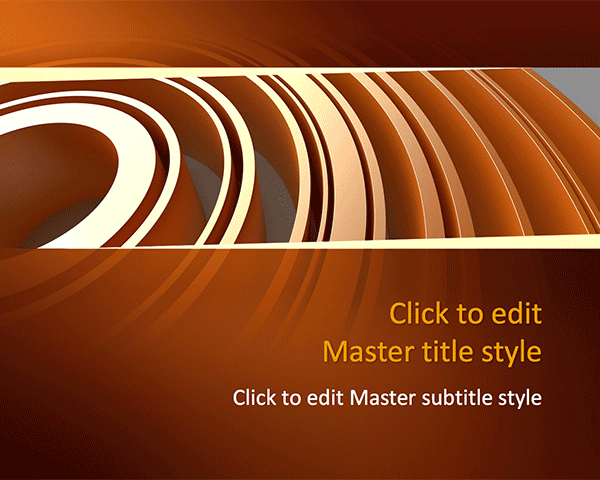
FREE PowerPoint Templates for Presentations Download presentation templates with attractive designs, layouts and styles. Thousands of slides & templates to choose from.
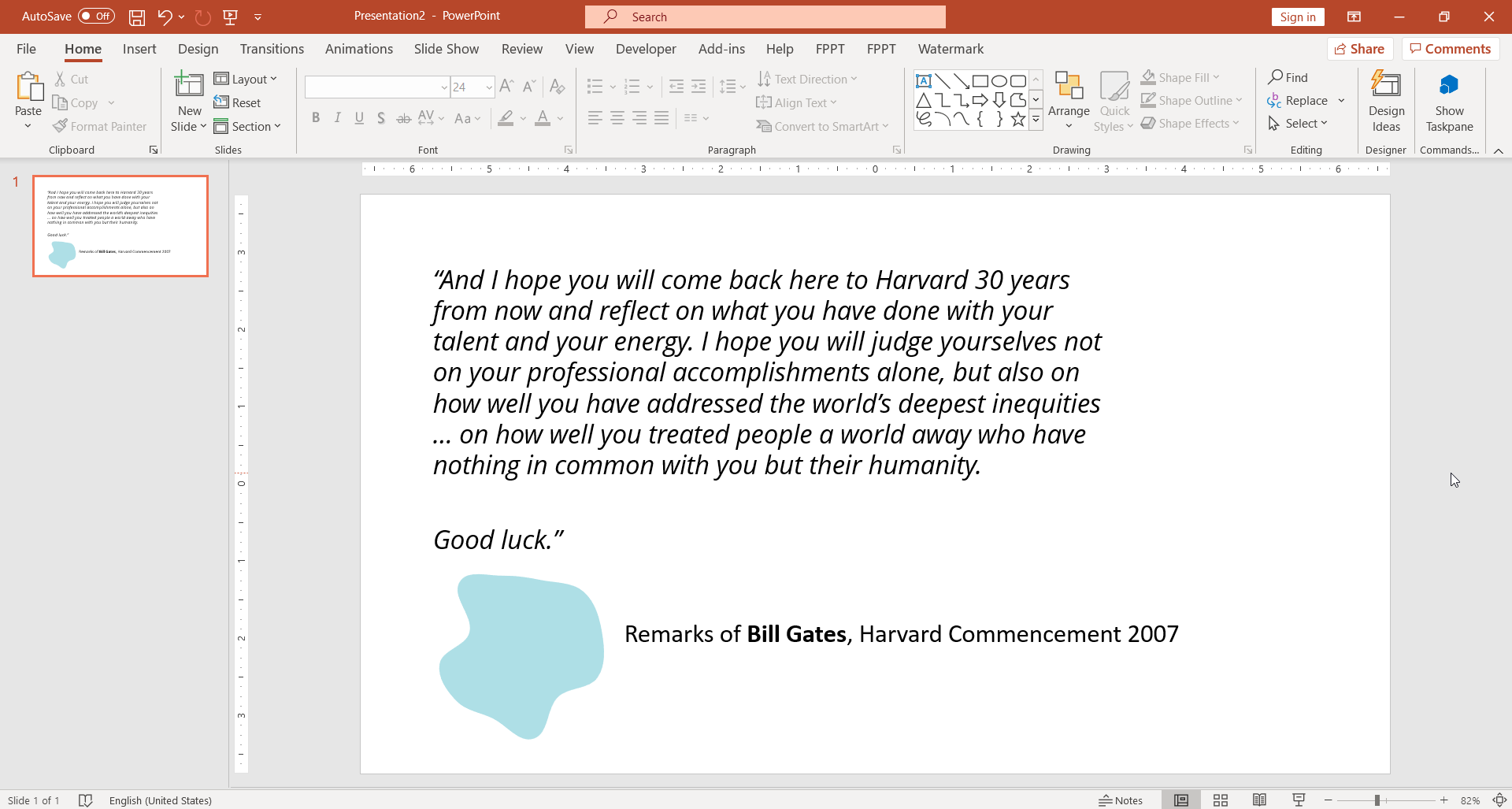
Funny Closing Remarks
You can also add a touch of humor to make things more interesting with a closing remark like these:
- “It is finally time to end the excruciating pain I have all given you, time to get some caffeine! Thank you!”
- “It’s been a pleasure torturing you all with convoluted statistics and wordy speeches, have a great day!”
- “Now that we have that out of the way, time for me to get back home before my parents ground me!”
- “I hope you were all unable to understand anything I said! Confused? Good! Have a good day”
Note: Such a closing remark might be suitable where you have been able to keep your audience laughing throughout the presentation session and the audience might be in the right mood to receive such a remark in a lighthearted manner.
Even when you crack a joke, make sure to follow it up with a formal comment like ‘Thank You’, ‘Good Bye’, ‘Good Evening’ or ‘Have a Great Day’. Say it with a smile, to make sure you don’t look rude or the audience does not misunderstand you in anyway.
While the below comment by Will Ferrell wasn’t a closing remark but it serves as a good example as to how you can end your presentation with some humor.
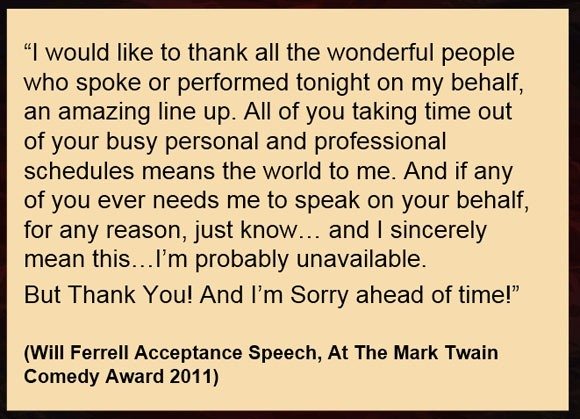
The presenter can support the close of the presentation with some visual slides. The thank you slides provided by SlideModel for example can be a good fit for this purpose. Read the full review from fixthephoto.com.
Tips for Adding Closing Remarks to Your Presentations
There are a number of ways by which you can add closing remarks to your presentations. Below are some methods you can use for leaving a major impact on the hearts and souls of your audience.
1. Adding closing remarks with the conclusion
This can be done to closely knit your conclusion with a closing remark which might inspire your audience. Crafting a compelling conclusion is an art in itself; understanding how to conclude a project effectively can be essential for creating a lasting impact. This tip is especially useful when drafting an effective conclusion for project.
2. Keeping the closing remarks separate from the conclusion
Sometimes it’s best to keep your closing remarks aside from the conclusion to avoid confusing the audience. This might be suitable when your closing remarks are meant to stand out apart from your conclusion. For example, your conclusion might be neutral but your closing remarks might provide your perspective on the topic and what you think is the best course of action.
3. Closing remarks and a summary of your presentation
When your closing remarks are closely tied to your conclusion/summary, you can use this method. Summarizing information can help the audience gather their thoughts and be reminded of essential aspects of your presentation, followed by a closing remark which resonates with the summarized content. You can effectively summarize your presentation by utilizing an online summarizer. A text summarizer can help to encompass the main points of your presentation and tie your closing remarks.
4. Using amazing facts to inspire your audience
This can be a very handy approach, i.e. to use a mind boggling fact to inspire the audience and to direct them towards your preferred opinion.
5. Call to action
Almost every type of presentation has a call to action. It is unlikely that a presenter in some way or the other will not be encouraging the audience to act, be it a sales presentation, motivational speech or a presentation about social issues. It could be as simple as adding a QR Code that links to your digital business card, thereby giving them an opportunity to contact you.
6. Reiterate Your Main Message
Your closing remarks should reinforce the main message or takeaway from your presentation. This helps in embedding the core idea in your audience’s mind, reminding them of what you want them to remember most.
7. Create an Emotional Connection
Closing remarks that tap into emotions can leave a lasting impression. A touching story, an inspiring quote, or a call to personal action can help create this emotional resonance, making your presentation more memorable.

8. Ensure Clarity and Brevity
While crafting your closing remarks, remember to keep them concise and clear. Avoid using jargon or complex sentences, and aim for straightforward language that your audience can easily comprehend.
9. End with a Call to Action
If applicable, give your audience something to do after your presentation. Whether it’s visiting a website, reading a book, or making a change in their life, a call to action gives your audience a practical next step. You can use the Call-To-Action to end your speech. Pro Tip: Do not forget to add your phone number and business email address as a part of your call to action.
10. Thank Your Audience
It’s always polite and effective to thank your audience in your closing remarks. Showing appreciation for their time and attention helps to foster a positive relationship and leaves a favorable impression. Use Thank you slides when you end your presentation.
11. Use Visual Aids
To enhance your closing remarks, consider using visual aids such as slides or infographics. These can summarize your main points, reinforce your message, and make your remarks more engaging and impactful.
12. Practice Delivery
Your closing remarks aren’t just about what you say, but also how you say it. Practice your slideshow and the presentation delivery to ensure you convey your message with confidence and clarity. Consider your tone, pace, and body language, as these can significantly affect your audience’s perception of your remarks. You can use tools like the Presentation Coach to rehearse your presentation.
Final words
We hope it will help you deliver a memorable presentation by ending it with proper closing remarks. Make sure that your audience feels satisfied after hearing the end of your speech. Ending on an optimistic note may leave a lasting impression on them, which is what matters the most in such professional events like interviews and presentations.
About Farshad
IT professional, communications specialist and Blogger!
View other posts by Farshad »
One comment on “ Closing Remarks for Presentations (in 2024) with Tips & Examples ”
This was very helpful. Thank you.
Leave a Comment Cancel reply
Your email address will not be published. Required fields are marked *
Save my name, email, and website in this browser for the next time I comment.
Sign up to our newsletter
We will send you our curated collections to your email weekly. No spam, promise!
12 Powerful Closing Lines for a Class Presentation
Hrideep barot.
- Presentation , Public Speaking

Powerful closing lines have been a part of some of the most crucial moments in history. They’re the last notes in a symphony, the final strokes on a masterpiece, and in the context of class presentations , they’re the unforgettable conclusion that leaves your classmates in awe.
In this comprehensive guide, we’re about to unveil the artistry behind crafting unforgettable closing lines for class presentations. Whether you’re a student stepping into the spotlight to deliver a class project or an educator determined to inspire and captivate your students, never underestimate the profound impact a closing statement can have. It’s the final brushstroke on the canvas, the last note in a symphony, the lingering taste of a delicious meal. The closing lines you choose can elevate your class presentation from the realm of the ordinary to the extraordinary.
Picture this: you’ve meticulously researched your topic, crafted a compelling narrative, and delivered your content with enthusiasm. Your audience is hanging onto your every word. Now, as you reach the crescendo of your presentation , it’s time for that final flourish, that memorable conclusion that leaves an indelible mark.
In the words that follow, we’ll delve into the art and science of crafting closing lines that resonate, leaving your audience both informed and inspired. We’ll explore 12 powerful closing lines, each with its unique charm and ability to transform your presentation’s impact.
So, get ready to embark on a journey through the world of impactful conclusions . Whether you’re a student striving for an A+ or an educator aiming to ignite curiosity and learning, our guide will equip you with the tools you need to conclude your class presentation with finesse.
Together, let’s dive right in and unlock the magic of memorable Conclusions!
1. the call to action.
Inspire your audience to take action or reflect on your presentation’s key message. Encourage them to join you on a journey of discovery or change. Example: “Now, let’s embark on this adventure together and make a difference in our world.”
2. The Thought-Provoking Quote
Close with a thought-provoking quote that encapsulates the essence of your presentation. It should leave your audience pondering its meaning. Example: “As Albert Einstein once said, ‘Imagination is more important than knowledge.’ Let’s keep imagining and learning together.”
3. The Challenge
Present a challenge to your audience, something they can take on or think about further. Example: “I challenge each of you to think beyond the ordinary, to question, to innovate, and to be the change you wish to see.”
4. The Visionary Statement
Paint a vivid picture of the future you’ve explored in your presentation. Give your audience a glimpse of what could be if they embrace the ideas presented. Example: “Imagine a world where every act of kindness ripples through society. That world is within our grasp.”
5. The Personal Anecdote
Share a personal anecdote or story that ties back to your presentation’s theme. It adds a human touch and makes your message relatable. Example: “I’ll never forget the day I realized the power of perseverance. Just like I did, we can all overcome challenges.”
6. The Call for Questions
Open the floor for questions, showing your willingness to engage with your audience further. It invites discussion and deeper exploration. Example: “I’m here to answer any questions or hear your thoughts. Who’d like to start?”
7. The Visual Recap
Display a visual summary of your key points on the screen. It reinforces your message and helps your audience remember the main takeaways. Example: “Before we conclude, let’s quickly recap the journey we’ve taken.”
8. The Emotional Appeal
Appeal to your audience’s emotions, expressing gratitude or highlighting shared values. Example: “Thank you for being a part of this journey. Together, we’ve shown that compassion and collaboration can drive change.”
9. The Future Collaboration
Suggest future collaboration or exploration of the topic together. It keeps the conversation going beyond the presentation. Example: “Let’s continue this conversation, explore new ideas, and make a difference together.”
10. The Bold Statement
Make a bold statement or prediction related to your topic. It should leave your audience excited about what lies ahead. Example: “The future of [topic] is bright, and together, we will shape it.”
11. The Call for Feedback
Encourage feedback from your audience, showing your commitment to improvement and continuous learning. Example: “Your feedback is invaluable. Please share your thoughts, suggestions, and ideas with me.”
12. The Acknowledgment of Gratitude
Express sincere gratitude to your audience for their time and attention. It’s a simple yet powerful way to wrap up. Example: “I’m truly grateful for your presence today. Thank you for being such an engaging audience.”
Examples of Powerful Closing Lines
Martin luther king jr.’s “i have a dream” speech (1963):.
In one of the most iconic speeches in history, Martin Luther King Jr. closed with the powerful words, “ Free at last! Free at last! Thank God Almighty, we are free at last! ”
This memorable closing statement from the March on Washington for Jobs and Freedom not only marked the culmination of his vision for racial equality but also became a symbol of hope and inspiration for civil rights movements worldwide. It continues to resonate today as a call for justice, freedom, and equality.
Neil Armstrong’s Words on the Moon (1969):
As Neil Armstrong took humanity’s first step onto the lunar surface, he uttered the famous words, “That’s one small step for [a] man, one giant leap for mankind.” This historic closing statement not only marked a momentous achievement in space exploration but also symbolized humanity’s indomitable spirit of exploration and discovery. It remains etched in history as a testament to human ingenuity and curiosity, inspiring generations of scientists, explorers, and dreamers.
These memorable closing statements from history serve as valuable lessons, urging us to adopt their qualities and incorporate them into our own lives.
Winston Churchill’s famous speech delivered at the end of World War II:
“ Now this is not the end. It is not even the beginning of the end. But it is, perhaps, the end of the beginning .”
Winston Churchill delivered this closing statement in his speech on November 10, 1942, following the Allied victory in the Second Battle of El Alamein during World War II. With these words, Churchill conveyed that while a significant victory had been achieved, the war was far from over. He provided hope for the future and the continued determination to prevail against Nazi Germany, acknowledging that the hardest battles were yet to come. This statement has since become emblematic of perseverance in the face of adversity.
John F. Kennedy’s Inaugural Address (1961):
John F. Kennedy’s inaugural address in 1961 is renowned for its call to civic duty and personal responsibility. Here’s a bit more context and the preceding lines leading up to the famous closing line:
“ And so, my fellow Americans, ask not what your country can do for you; ask what you can do for your country. “
This statement marked the culmination of Kennedy’s message of shared responsibility and unity as he assumed the presidency. In the address, he addressed the challenges and opportunities facing the nation at the height of the Cold War. Kennedy inspired hope and a sense of purpose, urging Americans to contribute actively to their country’s well-being.
How can we form Powerful Closing Statements :
1. the visionary challenge:.
- Example 1: “Together, let’s envision a world where every child has access to quality education, where poverty becomes a relic of the past, and where innovation knows no bounds. As we embark on this journey, remember that change begins with a single step, and each of us has the power to be that change.”
- Elaboration : This closing statement invites the audience to envision a better future while emphasizing individual agency in creating that change. It challenges listeners to become active participants in a collective vision.
2. The Invitation for Reflection:
- Example 2: “As we conclude today, I invite you to take a moment to reflect on the lessons learned, the connections forged, and the possibilities ahead. Remember that learning is a lifelong journey, and our experiences today are just the beginning of a greater adventure.”
- Elaboration : This closing statement encourages introspection and emphasizes the continuous nature of learning. It leaves the audience with a sense of ongoing growth and exploration.
These original examples of powerful closing statements are designed to inspire and leave a lasting impact on the audience, much like the historical examples mentioned earlier. They encourage forward-thinking, reflection, and a sense of shared purpose.
What is THE BEST way to end a presentation?
I. the surprise element:.
Leave your audience with a surprising fact or unexpected twist related to your topic. A well-placed surprise can make your presentation memorable.
Example of Topic: Environmental Conservation
Closing: “Did you know that a single recycled plastic bottle saves enough energy to power a laptop for 25 minutes? So, every time you toss one in the recycling bin, you’re literally fueling your own productivity!”
II. Visual Metaphor:
Use a visual metaphor or analogy to drive home your main message. An evocative image or comparison can linger in your audience’s mind.
Example of Topic: Teamwork and Collaboration
Closing: “Just like the gears in a well-oiled machine work together seamlessly, our teamwork can propel us to success. Let’s keep our projects running as smoothly as these gears.”
III. Personal Connection:
Share a brief personal anecdote or experience that ties into your presentation’s theme. Connecting on a personal level can create a stronger bond with your audience.
Example of Topic: Overcoming Challenges
Closing: “When I faced a similar obstacle during my internship last summer, I thought it was insurmountable. But I persisted, and it taught me that perseverance pays off. I hope my experience inspires you to push through your challenges as well.”
IV. Open-Ended Question:
Instead of a call to action, ask an open-ended question that encourages contemplation. This leaves your audience with something to ponder after your presentation.
Example of Topic: Ethics in Business
Closing: “As we conclude, I’d like to leave you with this question: What role do ethics play in shaping the future of business? I encourage you to reflect on this and share your thoughts in our discussion after the presentation.”
V. A Powerful Image:
Display a single striking image that encapsulates the essence of your message. Visual impact can sometimes convey more than words.
Example of Topic: History of Space Exploration
Closing: “This image of Earthrise taken from the Apollo 8 mission reminds us of our place in the cosmos and the importance of exploring the unknown. Let it inspire your curiosity and wonder about the universe.”
VI. Contrast and Resolution:
Highlight a before-and-after scenario related to your topic. Show how your presentation has provided a solution or resolution to a problem.
Example of Topic: Health and Fitness
Closing: “Remember the ‘before’ picture we saw at the beginning of this presentation? Today, we’ve explored the path to a healthier lifestyle. Let’s embrace this transformation and make positive changes together.”
VII. Provocative Statement:
Make a thought-provoking statement that challenges conventional thinking. Stimulating intellectual curiosity can leave a lasting impression.
Example of Topic: Artificial Intelligence
Closing: “In a world where machines are becoming increasingly intelligent, the real question is, ‘What does it mean to be human?’ Let’s keep pondering this as we navigate the age of AI.”
VIII. Audience Participation Challenge:
Challenge your audience to apply a concept or principle from your presentation in their daily lives. Encourage them to share their experiences later.
Example of Topic: Effective Study Techniques
Closing: “Now, I challenge each of you to implement one new study strategy from today’s presentation for the next week and share your experiences with the class. Let’s see how it impacts our learning.”
IX. Visual Progression:
Use a series of visual slides that depict progress or transformation. Show how your presentation has advanced the understanding of your topic.
Example of Topic: Scientific Discovery
Closing: “From the initial observations to the breakthrough experiments we discussed today, science continually evolves. Let’s continue to explore, learn, and advance our understanding of the natural world.”
What Is a Good Closing Sentence For a Thank You Note:
1. the reflecting farewell :.
Sometimes, sticking to the classics is the way to go. Example: “In conclusion, let’s remember that it’s through our collective efforts that we can make a positive difference. Thank you for being part of this journey.”
This option is compelling as it inspires a sense of unity and purpose, encouraging the audience to reflect on the speech’s message.
2. The Forward-Looking Finish Line:
Want to keep the connection alive? Try a closing like, “Looking forward to catching up soon!” It adds a hint of anticipation and suggests that your gratitude isn’t just a one-time thing; you’re excited about future encounters.
3. The Appreciative Gesture:
To infuse your closing with warmth, make your thank-you note feel like a heartfelt connection. Example: To sum it up, your presence here today has added immeasurable value to this occasion. Thank you for being a part of this memorable moment.”
This sentence is strong because it emphasizes the audience’s importance in the event, making them feel appreciated and valued.
4. The Purposeful Note :
This one is especially unique as it leaves a sense of purpose and responsibility behind, also a technique used by some of the greatest leaders ever.
Example: “To wrap things up, I’d like to extend my sincere thanks for your time and consideration. May the lessons shared today resonate in our hearts and guide us forward.”
This closing is powerful because it leaves the audience with a sense of purpose and reflection, reinforcing the speech’s key takeaways.
5. The Creating Impact :
Leaving the audience feeling important and validated is very important. By saying that they make a difference or that they can leave an impact gives them a sense of power and control.
Example: “In summary, your support means the world to me, and I’m grateful beyond words. Let’s continue to make a positive impact together.”
This closing is effective as it conveys deep appreciation and invites the audience to be part of ongoing positive endeavors.
6. The Grateful Signature:
If you want to emphasize your thankfulness one last time, end with, “With heartfelt thanks.” It’s a signature of gratitude, leaving no doubt about the sincerity of your appreciation.
Example: “In closing, I want to express my heartfelt gratitude once more for your presence today. Your support and attention have made this moment truly special.”
This closing sentence is effective because it reiterates gratitude, leaving a lasting impression of appreciation in the audience’s minds.
Let us use an example to get a better understanding:
I want to extend my heartfelt gratitude to all of you for being such an attentive and engaging audience during my recent speech. Your presence and active participation added depth and meaning to the discussion, and it was an absolute pleasure to share my thoughts with you.
Your support and enthusiasm are truly appreciated, and I hope the insights shared in my speech continue to resonate with you. If you have any further questions or thoughts, please don’t hesitate to reach out. Thank you once again for your time and attention.
How Can I End a Presentation Without Saying Thank You:
While expressing gratitude is a common way to conclude a presentation, there are moments when you might want to skip the traditional “thank you.” Here are some creative alternatives to wrap up your presentation effectively:
The Forward-Looking Statement:
Instead of looking back with gratitude, look forward with anticipation. Share your excitement about what lies ahead for your audience. For example, “I can’t wait to see the incredible impact we’ll make together.”
The Challenge Accepted:
Challenge your audience to take what they’ve learned and put it into action immediately. Encourage them to apply your insights and make a positive change. For instance, “I challenge each of you to implement one key takeaway from today’s presentation within the next week.”
The Future Vision:
Paint a compelling vision of the future that aligns with your presentation’s theme. Describe the possibilities and benefits that await if your audience embraces your ideas. Use vivid language to help them visualize this future.
The Open-Ended Question:
Pose a thought-provoking question that invites your audience to reflect and engage. This question should leave them pondering and encourage discussions beyond the presentation’s end.
The Inspiring Quote:
Share an inspiring quote that encapsulates the essence of your presentation. This can be a memorable way to conclude and leave your audience with a powerful message to remember.
The Call to Action:
If your presentation is focused on action, end with a clear call to action. Prompt your audience to do something meaningful based on your presentation’s content. It could be signing up for a workshop, joining a cause, or volunteering.
The Visual Surprise :
End with a visual surprise, such as revealing a compelling image or infographic that reinforces your message. Visuals can leave a strong impression and drive your point home.
The Personal Connection:
Share a personal anecdote or story that relates to your presentation. Make it relatable and memorable, leaving your audience with a connection to your message.
The Group Activity:
If your presentation allows, engage your audience in a brief group activity that reinforces your message or encourages collaboration and interaction.
The Poignant Pause:
Conclude with a moment of silence or reflection. Allow your audience to absorb the key takeaways and reflect on the impact of your presentation.
Remember, the choice of how to conclude your presentation without saying “thank you” should align with your overall message, purpose, and audience. It’s an opportunity to leave a lasting impression and guide your audience toward the desired action or mindset.
Conclusion:
Throughout this exploration of closing statements, we’ve journeyed from understanding the significance of powerful closings to uncovering various ways to leave a lasting impact. From memorable historical examples to creative alternatives, we’ve delved into the art of concluding with finesse.
Closing statements are not mere formalities; they are the key to resonating with your audience, leaving an indelible mark, and driving your message home. Whether you choose to inspire, challenge, or provoke thought, the closing is your final opportunity to connect deeply.
So, when you find yourself at the brink of a presentation’s conclusion, remember the artistry of the closing statement. Use it wisely, weave it skillfully, and watch as your words echo in the hearts and minds of your audience, carrying the essence of your message long after the final word is spoken.
To learn public speaking and how to communicate effectively at the workplace you can reach out to us here.
Enroll in our transformative 1:1 Coaching Program
Schedule a call with our expert communication coach to know if this program would be the right fit for you

7 Best Places to Get Public Speaking Certification

Review of “How to Win Friends and Influence People” by Dale Carnegie

The Best Online Resources for Public Speakers

- [email protected]
- +91 81691 99570
Get our latest tips and tricks in your inbox always
Copyright © 2023 Frantically Speaking All rights reserved

IMAGES
VIDEO
COMMENTS
30 Example Phrases: How to Conclude a Presentation. 1. “In summary, let’s revisit the key takeaways from today’s presentation.” 2. “Thank you for your attention. Let’s move forward together.” 3. “That brings us to the end. I’m open to any questions you may have.” 4. “I’ll leave you with this final thought to ponder as we ...
May 9, 2018 · A closing in a presentation should be short and clear. It should summarize your key points. And, most importantly, it should be powerful. In today’s lesson, you’re going to learn about 3 ways to make your closing more powerful. Plus you’ll learn useful key expressions you can use in your presentation.
Jan 23, 2023 · 6 Questions to Generate an Ending for Your Presentation . You’ve told an engaging story, but why end your presentation without leaving your audience a clear message or call to action? Here are six great questions you can ask yourself to generate an ending for your presentation or keynote talk.
Plan Your Closing Remarks Word for Word You have to be careful about how you end your speech or presentation, so planning your conclusion word for word is the best way to go. Ask yourself what the purpose of this speech is, and your answer should involve the actions that you want to see be taken by your listeners after you finish speaking.
Nov 19, 2024 · 3. Closing remarks and a summary of your presentation. When your closing remarks are closely tied to your conclusion/summary, you can use this method. Summarizing information can help the audience gather their thoughts and be reminded of essential aspects of your presentation, followed by a closing remark which resonates with the summarized ...
In this comprehensive guide, we’re about to unveil the artistry behind crafting unforgettable closing lines for class presentations. Whether you’re a student stepping into the spotlight to deliver a class project or an educator determined to inspire and captivate your students, never underestimate the profound impact a closing statement can have.